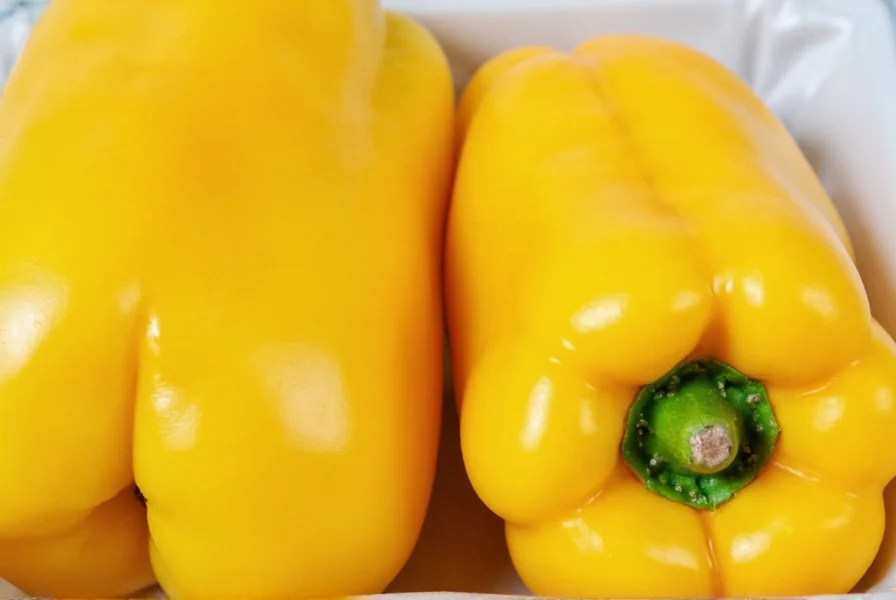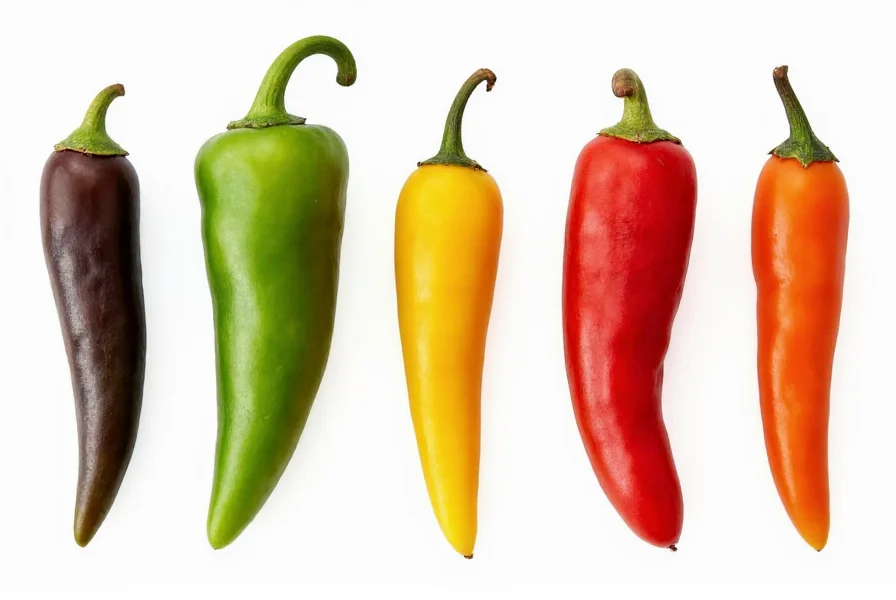When you're preparing Italian or Mediterranean dishes that call for cubanelle peppers but can't find them at your local market, knowing the right substitute becomes essential. These mild, sweet Italian frying peppers are prized for their thin walls, subtle flavor, and versatility in cooking. Understanding what makes cubanelle peppers unique helps identify the most appropriate alternatives that won't compromise your dish's integrity.
Understanding Cubanelle Peppers
Cubanelles, also known as Italian frying peppers or sweet Italian peppers, register between 0-1,000 on the Scoville scale, making them significantly milder than jalapeños (2,500-8,000 SHU) but with more flavor complexity than standard bell peppers. Their thin walls (approximately 1/8 inch thick) allow them to cook quickly without becoming tough, and their elongated shape (typically 6-8 inches long) makes them ideal for stuffing. When selecting a cubanelle pepper substitute, consider three critical factors: heat level, wall thickness, and flavor profile.
Top Cubanelle Pepper Substitutes Ranked
Not all pepper alternatives work equally well across different cooking applications. Here's how the most common substitutes compare for various culinary uses:
| Pepper Type | Scoville Units | Wall Thickness | Best For | Substitution Ratio |
|---|---|---|---|---|
| Yellow/Green Bell Pepper | 0 | Medium | Stuffed peppers, sautéing, roasting | 1:1 |
| Poblano Pepper | 1,000-2,000 | Thick | Chiles rellenos, soups, stews | 1:1 (remove seeds for milder) |
| Banana Pepper | 0-500 | Thin | Pickling, salads, sandwiches | 1:1 |
| Shishito Pepper | 50-200 | Very Thin | Quick sautéing, blistering | 1.5:1 (smaller size) |
Best Substitutes by Cooking Application
For Stuffed Pepper Recipes
When searching for the best cubanelle pepper substitute for stuffed peppers, bell peppers are your most reliable option. Their similar size and shape allow them to hold fillings properly, while their mild flavor won't overpower other ingredients. Yellow bell peppers provide the closest flavor match, though green works well too. Cut them lengthwise, remove seeds, and blanch briefly before stuffing to prevent cracking during baking. This cubanelle vs bell pepper substitution works particularly well in Italian stuffed pepper recipes where the delicate flavor of cubanelles is essential.

For Italian and Mediterranean Dishes
When making Italian recipes that traditionally use cubanelles, such as peperonata or stuffed peppers, yellow bell peppers provide the most authentic flavor profile. Their sweetness closely matches mature cubanelles, which develop yellow or red hues when fully ripe. For a more traditional appearance, consider using a combination of 75% yellow bell pepper and 25% red bell pepper to mimic the color variation of cubanelles. This cubanelle pepper replacement in Italian recipes maintains the dish's integrity while remaining accessible to home cooks.
For Pickling and Fresh Applications
Banana peppers serve as the closest visual match for cubanelles when pickling or using in fresh applications like salads and sandwiches. Though slightly tangier than cubanelles, their similar shape and thin walls make them excellent substitutes. When pickling, add a pinch of sugar to the brine to balance the tanginess and better approximate cubanelle's mild sweetness. For fresh applications, this cubanelle pepper alternative works particularly well in antipasto platters where appearance matters as much as flavor.
Adjusting Recipes When Substituting
Successful substitution requires more than just swapping one pepper for another. Consider these adjustments based on your chosen alternative:
- For thicker-walled peppers like poblanos: Reduce cooking time by 25% or pre-cook briefly to prevent undercooking the filling in stuffed pepper recipes
- For spicier alternatives: Remove seeds and membranes completely, even when substituting poblanos which are generally mild
- For sweeter substitutes: Balance with a splash of red wine vinegar when using in savory dishes to maintain flavor complexity
- When substituting banana peppers: Add a pinch of sugar to compensate for their natural tanginess in cooked applications
Common Mistakes to Avoid
Many home cooks make critical errors when substituting cubanelle peppers that compromise their dishes. The most frequent issue is using overly spicy alternatives like jalapeños or serranos, which completely alter the dish's flavor profile. Remember that cubanelles are specifically chosen for their mildness in traditional recipes. Another common mistake is not adjusting cooking times for peppers with different wall thicknesses—thicker peppers require longer cooking to become tender without burning.

When to Grow Your Own
If you frequently cook with cubanelles and struggle to find them, consider growing your own. Cubanelle plants thrive in containers and produce abundant yields with minimal care. Start seeds indoors 8-10 weeks before your last frost date, then transplant outdoors when soil reaches 65°F. The plants typically mature in 60-70 days and will produce peppers continuously throughout the growing season. This solution works especially well for those seeking a reliable source of fresh cubanelles for their favorite recipes without depending on seasonal availability at grocery stores.
FAQs About Cubanelle Pepper Substitutes
Can I use bell peppers instead of cubanelle peppers in stuffed pepper recipes?
Yes, bell peppers make an excellent 1:1 substitute for cubanelle peppers in stuffed pepper recipes. Yellow bell peppers provide the closest flavor match, though green works well too. For best results, blanch the bell peppers briefly before stuffing to prevent cracking during baking. This cubanelle vs bell pepper substitution maintains the structural integrity needed for stuffed dishes while delivering a similar mild flavor profile.
What's the best mild pepper substitute for cubanelle in Italian cooking?
Yellow bell peppers are the best mild pepper substitute for cubanelle in Italian cooking. Their sweetness closely matches mature cubanelles, which develop yellow hues when fully ripe. For more authentic flavor in dishes like peperonata, use a combination of 75% yellow bell pepper and 25% red bell pepper to mimic the color variation of cubanelles while maintaining the mild flavor profile essential to traditional Italian recipes.
How do I substitute poblano peppers for cubanelles without adding too much heat?
To substitute poblano peppers for cubanelles without adding excessive heat, remove all seeds and white membranes before use, as these contain most of the capsaicin. Poblanos are slightly hotter than cubanelles (1,000-2,000 vs 0-1,000 Scoville units), but proper preparation minimizes this difference. For stuffed pepper recipes, reduce cooking time by 25% since poblanos have thicker walls that take longer to become tender. This approach works well when you need a cubanelle pepper alternative with similar flavor complexity but slightly more depth.
Can I use banana peppers as a cubanelle substitute for pickling?
Yes, banana peppers make an excellent cubanelle pepper alternative for pickling due to their similar shape and thin walls. While banana peppers have a slightly tangier flavor than cubanelles, you can balance this by adding a pinch of sugar to your pickling brine. For the closest flavor match, select banana peppers that are still yellow rather than fully ripe red ones. This substitution works particularly well for antipasto platters where appearance matters as much as flavor.
What's the difference between cubanelle and Anaheim peppers as substitutes?
Cubanelles are significantly milder (0-1,000 Scoville units) than Anaheim peppers (500-2,500 SHU), with thinner walls and a sweeter flavor profile. While Anaheims can substitute for cubanelles in some applications, they introduce more heat and require longer cooking times due to thicker walls. For most recipes calling for cubanelles, bell peppers or banana peppers make better substitutes than Anaheims unless you specifically want to add mild heat to your dish. This distinction is crucial when selecting a cubanelle pepper replacement for sensitive palates or traditional recipes where heat isn't intended.











 浙公网安备
33010002000092号
浙公网安备
33010002000092号 浙B2-20120091-4
浙B2-20120091-4